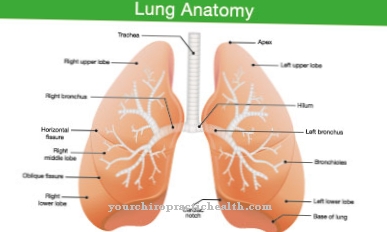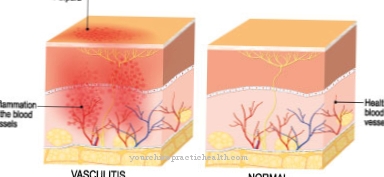Cradle cap is the collective term for infantile seborrheic dermatitis, which causes scaly patches on the scalp of infants. Thick crusts and scales can develop, but cradle cap can not be described as a serious disease and disappears within a few months.
What is cradle cap

© farbkombinat - stock.adobe.com
Cradle cap is a yellowish, oily, scaly rash that shows up on the scalp within 3 months of giving birth.
The inflammatory, non-contagious rash is usually itchy and safe for a baby. In the most common cases, the cradle cap lies directly on the top of the skull, and often around the ear, the eyebrows or on the eyelids. Around half of all babies worldwide have cradle cap, most of them suffer from a mild variant of the disease.
Cradle cap is sometimes mistaken for another skin condition called infantile eczema. The main difference, however, is that eczema usually causes significantly more itching. As a rule, cradle cap will no longer show up at a later age, although recent studies indicate that around 15 percent of affected children are prone to eczema 10 years later.
causes
The exact cause of Cradle cap cannot be clearly identified, in no case poor hygiene or allergies are decisive.
For one, it is believed that hormones transferred from the mother to the baby before birth create an excessive production of sebum, which clogs the sebum glands and hair follicles. A lack of biotin intake seems to be closely related to this.
Since biotin has an influence on fatty acid biosynthesis, overactive sebum production in the skin of newborns can lead to an increased release of a fatty substance that binds old skin cells on the scalp instead of rejecting them.
Another cause of cradle cap is a yeast (Malassezia), which multiplies in the sebum together with bacteria. This thesis is supported by the fact that antifungal treatment with ketoconazole is often effective.
Symptoms, ailments & signs
The first sign of the presence of cradle cap are changes in the skin, especially in hairy areas on the head and face. The appearance is strongly reminiscent of burnt milk and also smells similar. With these first signs, cradle cap can be clearly distinguished from harmless skin changes in babies, such as "gneiss".
The symptoms of the cradle cap show up immediately after their appearance - the skin itches and shows scaly crusts in the affected areas. Cradle cap appears around the age of 4 months - babies at this age cannot be permanently prevented from scratching the affected areas of the skin. Scratching the individual areas sometimes leads to the skin areas becoming inflamed and festering.
Such inflamed wounds are uncomfortable and painful, and affected babies are often uncomfortable and tearful. Some babies suffer from insomnia; the permanent itching - which is usually more pronounced in the evening than in the morning - does not allow them to rest. In the affected areas of the skin, the hair usually falls out. To ensure that the hair can grow back normally after the cradle cap has subsided, excessive scarring by scratching must be avoided. Cradle cap is often a harbinger of neurodermatitis.
Diagnosis & course
Cradle cap shows up as light white or yellowish flaking or thick, oily crusts on the scalp. Similar symptoms can also appear on the ears, eyelids, nose and in the folds of the skin. Medical intervention is only recommended when the cradle cap becomes red, spreads to the mouth and ears, or diaper rash breaks out.
Severe cases of cradle cap, especially cracking or bleeding of the skin, can provide a nutritious place for bacteria to build up. Occasionally, cradle cap can also be linked to immune system disorders.
A doctor should therefore be consulted in the event of developmental disorders or diarrhea. In the event of a medical consultation, parents should provide information about the duration of the cradle cap, care products used and countermeasures that have been started in order to facilitate a diagnosis.
Complications
The cradle cap primarily causes various complaints that occur on the scalp. These complaints are very uncomfortable for those affected and can also lead to a feeling of shame or to inferiority complexes. The quality of life is significantly reduced by the complaints. Redness and itching occur on the scalp.
Furthermore, blisters can also form, but these can also affect the face. In the face in particular, the symptoms lead to reduced aesthetics for the patient. Young children can also suffer from this disease and often have to scratch due to the itching. The itching itself is usually only exacerbated and the constant scratching can also lead to bleeding on the skin.
After all, the bleeding often leads to infections or inflammations. Furthermore, diarrhea or developmental disorders can occur. The treatment of this disease is mostly done with the help of shampoos or other care products. There are no particular complications and the symptoms can be resolved relatively quickly and easily. The life expectancy of the child is not affected by the symptoms.
When should you go to the doctor?
The cradle cap is one of the natural phenomena after the birth of a person. Comprehensive medical examinations of the newborn are usually carried out immediately after delivery. Anomalies and malfunctions are noticed and documented. In the first few weeks and months there are further routine examinations by a pediatrician. If there are irregularities or special features develop, these can be discussed during the initial examinations. The cradle cap is a crust on the skin. If the incrustations do not develop independently within the first six months of life, a doctor should be consulted. Unpleasant itching is one of the symptoms that accompany cradle cap.
Infants in particular are helplessly exposed to the situation. If this is very strong or causes an increase in symptoms, a doctor should therefore be consulted. If there are open wounds on the body, sterile wound care is required for the affected areas. If parents cannot ensure the sterility of the supply sufficiently, a visit to a doctor is recommended to avoid side effects. In severe cases, there is an alternative risk of sepsis. Blood poisoning can lead to premature death and should therefore be treated medically as soon as possible. If pustules, poplars, swellings form or reddening of the skin occurs, a doctor is required.
Treatment & Therapy
Cradle cap Usually does not require medical treatment and disappears within a few weeks to months. For many mild cases of cradle cap, the use of virgin olive oil has proven its worth.
The oil is rubbed into the scalp and should act for 15-20 minutes. Then the head is washed with a mild baby shampoo and the scales are combed out with a very fine comb. The scalp can also be gently massaged with a washcloth or soft brush to loosen the flakes.
If frequent shampooing does not change the use of a stronger shampoo with added tar or an antifungal soap with ketoconazole (2%) may be indicated. Anti-dandruff shampoos that contain salicylic acid are not recommended for use on babies because the toxic substances can be absorbed through the skin.
In severe cases, hydrocortisone cream can be postponed to reduce redness and inflammation. As a home remedy, massaging the scalp with small amounts of borage oil, aloe gel and tea tree oil twice a day have proven to be effective.
Outlook & forecast
Cradle cap is mostly a sign of chronic atopic skin eczema and therefore cannot be treated as a cause. Although the itching and the intensity of the suffering may decrease in the meantime, more violent attacks can be expected up to about the age of two. In rare cases, cradle cap can simply heal after a few months. If there is no transition to atopic eczema, the prospect can be given that the disease will not be reactivated and that there will be no associated skin complaints afterwards.
If the condition turns into chronic atopic eczema, the prognosis is unfavorable: These conditions are lifelong and possible therapies and successes must always be assessed on a case-by-case basis. The exact cause of these chronic skin conditions is unknown and they can be difficult to deal with. Various factors determine the further prognosis, including above all psychosomatic ones and the ability of the person affected to deal with the disease and oneself properly.
In many cases, very good therapeutic success can be achieved and major cuts in the quality of life are not necessarily to be expected.
prevention
A daily hair wash seems to be the easiest and most effective way to avert this Cradle cap to be. At the same time, it is recommended to ensure a balanced vitamin balance and in particular an adequate intake of vitamin B during pregnancy.
Aftercare
Cradle cap initially causes discomfort in the scalp. The child feels constant itching and redness, which can greatly reduce the quality of life. Aftercare is primarily concerned with alleviating the symptoms. Because if the cradle cap is repeatedly scraped open, scars and pigment disorders can remain.
Rubbing in skin-friendly oil can help to gently rub off the loose cuticle layers. This can also prevent skin irritation and allergic reactions. If the cradle cap is improperly removed, bleeding and inflammation can occur. Since cradle cap usually disappears on its own, aftercare therefore includes permanent monitoring of the development, which can be contained with the help of care products.
You can do that yourself
If the child suffers from cradle cap, various self-help measures and a few household and natural resources will help.
For mild complaints, herbal remedies and preparations from homeopathy help against cradle cap. For example, the herbs Figwort, Bärlapp and chamomile as well as globules with the active ingredients Calcium carbonicum, Graphites or Viola tricolor are effective. Pansy tea, which is applied to the dandruff and quickly helps against itching and inflammation, has also proven itself. A saline solution, which you can easily prepare yourself, helps against weeping areas. Dry crusts can be loosened by rubbing the head with oil in the evening before going to bed. Classic olive oil as well as burdock root and marigold oil are effective.
Parents should be careful not to let the child scratch off the scales themselves. This can irritate the skin and, in the worst case, lead to inflammation. A gentle baby shampoo or an application made from medicinal plants is better. If the symptoms do not go away despite all the measures taken, it is best to speak to the pediatrician again. If there are signs of atopic dermatitis, further precautionary measures must be taken in consultation with the doctor.


.jpg)
.jpg)


.jpg)


















.jpg)

.jpg)
